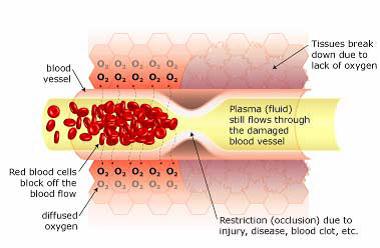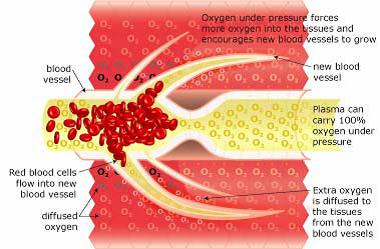How HBOT Helps
Hyperbaric Oxygen Therapy (HBOT) is an Advanced, Outpatient, Physician-referred therapy that improves the healing ability in compromised patients. HBOT is proven effective for use as an adjunct to traditional medical therapies and rehabilitation.
HBOT Increases the oxygen gradient in damaged, oxygen starved tissues. The oxygen you breathe in the chamber dissolves into your blood more efficiently, acting as a cellular energy catapult so that your plasma and tissues are saturated beyond a cellular level.
Scientifically speaking, in the mitochondria (or energy powerhouse of the cell), or hypoxic (or oxygen lacking or injured tissue) areas of the body, one molecule of regular oxygen combines with one mole of glucose and creates 2 moles of ATP. But with HBOT, one mole of Hyperbaric oxygen combines with one mole of glucose and creates 36 moles of ATP. That is a dramatic increase in energy provided for healing.
That’s why our name and acronym make sense.
Hyperbaric Oxygen Providing Energy for Healing
Hyperbaric Oxygenation Effects on Blood Flow
Normal blood flow
There is 21% oxygen in the air that we breathe, and our lungs transfer this oxygen to our red blood cells (via hemoglobin). These oxygen-filled red blood cells are carried around the body by the plasma (fluid), which travels through the blood vessels. The oxygen diffuses into the surrounding tissue ensuring that it is delivered to where it is needed most.

Restricted blood flow (ischemia) causes Hypoxia
When there is a restriction (occlusion) in blood flow due to surgery, illness, or injury, the red blood cells block the blood vessel and are unable to transfer oxygen to the cells on the other side of the occlusion. This causes swelling and starves the area of oxygen, causing hypoxia (a lack of oxygen); when this occurs the tissue begins to break down. Hypoxia triggers ‘apoptosis’ (programmed cellular degeneration – clumping and clustering of damaged nerve cells surrounded by healthy neuronal tracts).
Apoptosis modifies the expression of plasticity (the ability of the body to repair). Apoptotic bodies and altered DNA fragmentations are observed in the avascular ischemic region with increased inhibitory biochemical factors (proteins) released into the damaged parts of the brain and spinal cord causing further deterioration. Apoptosis has been identified in all neurodegenerative disorders including brain and spinal cord injury. Apoptosis fosters the cycle of continued dysfunction, degeneration and ultimate neuronal death.

Hyperbaric Oxygenation
Breathing 100% oxygen under pressure causes the oxygen to diffuse into the blood plasma. This oxygen-rich plasma is able to travel past the restriction, diffusing up to 3 times further into the tissue. The pressurized environment helps to reduce swelling and discomfort, while providing the body with at least 10-15 times its normal supply of oxygen to help repair tissue damaged by the original occlusion or subsequent hypoxic condition. Hyperbaric Oxygenation (HBOT) directly increases the saturation of tissue oxygenation, slowing and reversing hypoxic induced apoptosis – restoring blood supply to the compromised region by the development of new capillary networks (neovascularization) enabling the body to alter the course and impact of the disease process.

Neurovascular Regeneration
HBOT mobilizes the body’s circulating stem cells. American Journal Physiology – Heart and Circulatory Physiology (Nov 05)] reports a single 2-hour exposure to HBOT at 2 ATA doubles circulating CD34+ progenitor stem cells (primordial cells targeted to salvage and restore damaged structures); and at approx. 40-hours of HBOT; circulating CD34+ cells increases eight fold (800%).

Images by Malcolm R Hooper – HyperMED Australia
HBOT indications Approved by UHMS, the National Hyperbaric Committee to be Paid or Reimbursed by Insurance Companies.
The H.O.P.E. For Healing Institute is a physician referred out, patient medical rehabilitation facility that specializes in Tualing patients that have lingering or persistent health problems. We also treat patients with sub-clinical illness who do not need hospitalization but are simply too ill to allow for true quality of life.
The Food and drug administration has approved treatment for the first 13 indications to be paid by most insurance companies Hyperbaric Oxygen Therapy is not limited to healing just those 13 conditions. With a prescription, patients can receive treatment for a wide variety of conditions.
- Air or Gas Embolism
- Carbon Monoxide Poisoning / Cyanide Poisoning
- Clostridial Myositis and Gas Gangrene (Clostridial Myonecrosis)
- Crush Injury, Compartment Syndrome, and other Acute Traumatic Ischemias
- Decompression Sickness
- Enhancement of Healing in Selected Problem Wounds
- Exceptional Blood Loss Anemia
- Intracranial Abscess
- Necrotizing Soft Tissue Infections
- Osteomyelitis (Refractory)
- Delayed Radiation Injury (Soft Tissue and Bony Necrosis)
- Skin Grafts and Flaps (Compromised)
- Thermal Burns
Other Conditions That May Be Treated With a Physicians Permission
AutoImmune Related Disorders
- Chronic Fatigue Syndrome
- Fibromyalgia
- Lupus
- Scleroderma
- Silicone induced Disorders
- Guillan-Barre Syndrome
- Rheumatoid Arthritis
Cardiac Disorders
- Heart Attack, Myocardial Ischemia
- Aid to cardiac surgery and rehabilitation
Endocrine Disorders
- Diabetes
Gastrointestinal
- Colitis
- Chron’s Disease
- Gastric and Duodenal Ulcers
Hematology
- Acute and Chronic Anemia
Neurological Disorders
- Candidas and fungal infections
- Hypoxic birth disorders
- Parkinsons disease
- Spinal Cord Injury
- AIDS
- Autistic disorders
- Cerebral Edema
- Cerebral Palsy, epilepsy due to hypoxia
- Chemical poisoning (e.g. Pesticides)
- Flesh Eating Bacteria
- Headaches, cluster headaches, Migraines
- Lyme Disease
- Multiple Sclerosis
- Mycoplasma
- Near Drowning
- Near Hanging
- Neurovascular compression
- Peripheral nerve injury and neuropathies, demyelination
- RSD
- Spider Bite
- Stroke
- TOS
- Vegetative Coma
Opthalmology
- Macular degeneration
- Retinitis Pigmentosa
Orthopedic Disorders
- Bone Grafts
- Fracture repair, delayed and non-union
- Inflammatory arthritis
- Osteoporosis
- Post surgical instability
- Sacroiliac Syndrome
- Aid to prosthesis rehabilitative care
Otorhinolaryngology
- Acute acoustic trauma
- Sudden deafness
Peripheral Vascular Disorders
- Acute and Chronic arterial insufficiency
- Delayed wounds, recurrent ulcers and infections
Traumatology
- Closed Head injury
- Compartment syndrome
- soft tissue musculoskeletal injuries